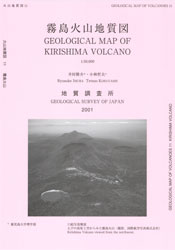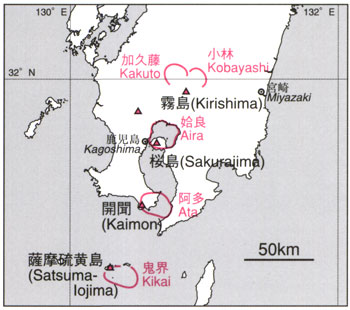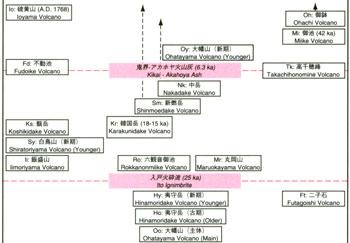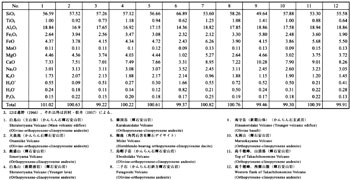Kirishima Volcano
Introduction / Geology of Kirishima Volcano and environs / Topography of Kirishima volcano
History of activities of Kirishima Volcano / Activities of historical times
Monitoring of volcanic activities / Points to be watched for disaster mitigation / Benefit of volcanoes
Acknowledgment / References
![]() PREV
PREV ![]() NEXT
NEXT
Introduction / Geology of Kirishima Volcano and environs / Topography of Kirishima volcano
IntroductionIntroduction
Kirishima Volcano Group is a generic designation of a cluster of Quaternary volcanoes situated at the boundary of Kagoshima and Miyazaki Prefectures, southern Kyushu. About 20 volcanoes and craters culminating at Karakunidake ( 1,700 m a.s.l. ) as the highest peak and Takachiho-no-Mine, famous for its relation to a myth, are concentrated in an oval shaped area with a size of 30 km by 20 km. The group is one of the active clusters of volcanoes in Japan and many records of eruptions are known for Ohachi and Shinmoedake in historical times. Also the area is popular tourist destination and visited by many people throughout the year. Therefore, prediction of eruption and disaster mitigation is extremely important. To achieve those, understanding of the nature of the group is essential.
This geologic map is a compilation of many studies and it is hoped that the map is utilized not only for future research, but also for prediction of eruption, sightseeing, education, and study of nature.
Geology of Kirishima Volcano and environs
The basement rocks of the Kirishima Volcano Group consist of sedimentary rocks belonging to Cretaceous Shimanto Group and early to middle Pleistocene volcanic rocks ( Kakuto Volcanic Rocks ). Those are distributed from SE to S of the volcano group as well as at the peripheries and outsides of Kakuto and Kobayashi basins to the north. In the vicinity of the volcano group, Ito Pyroclastic Flow deposits erupted from Aira caldera about 250,000 yBP is widely distributed covering basement rocks. Two basins north of Kirishima Volcano Group ( Kakuto and Kobayashi basins ) are interpreted as calderas ( ![]() Fig. 1 ). Kakuto basin was a lake up to about 250,000 years ago and lacustrine deposits are distributed.
Fig. 1 ). Kakuto basin was a lake up to about 250,000 years ago and lacustrine deposits are distributed.
Topography and geology of Kirishima Volcano
Large craters for the sizes of volcanoes, for example, Onamiike, Karakunidake, Shinmoedake, and Ohachi, are characteristic of Kirishima Volcano Group. A number of those craters are filled by water ( crater lakes ). Those craters were formed by explosive eruptions. Volcanic bodies and craters tend to align in NW-SE direction, but NE-SW trend perpendicular to the former is also developed. Futagoishi, at the SE side of the main volcanoes, and near the summit of Takachiho-no-Mine, existence of EW trending faults is inferred. Faults crossing central parts of craters in the direction of NE-SW are also inferred in the middle of the volcano group, Ebinodake, Karakunidake, and Onamiike. Distribution of volcanoes and faults are reflecting geologic structure and regional stress field of the area. At the northern foot of Hinamoridake and near Ioyama, northwest of Karakunidake, are distributed hummocky hills formed by collapses of the volcanic bodies.
Kirishima Volcano Group consists of new and old volcanic bodies, of which new ones are exposed on the surface, and old ones are little exposed at a foot area. In this map the former is named as younger Kirishima Volcano, and the latter older Kirishima Volcano. Radiometric ages of the former are younger than 200,000 years or so, while the latter are 1,200,000 to several hundreds of 1,000 years.
Kakuto Pyroclastic Flow deposits are about 300,000 years old separating younger and older Kirishima Volcano Group ( ![]() Fig. 2 ).
Fig. 2 ).
Pyroxene andesite is major type of rocks of old Kirishima Volcano while rocks of younger Kirishima Volcano are rich in varieties from olivine basalt, pyroxene andesite, to hornblende-bearing pyroxene dacite ( ![]() Table 1 ). Basalt and basaltic andesite occur in the eastern volcanoes such as Hinamoridake, Takachiho-no-Mine, and Ohachi. Volcanoes situated in the center and west consist mainly of pyroxene andesite irrespective of older or younger ages. Phenocrysts in basalt are plagioclase, olivine, and augite, and in andesite are augite, hypersthene, and opaque minerals often accompanied by olivine. Lava and dacitic pumice erupted from Kurinodake contains little hornblende phenocrysts.
Table 1 ). Basalt and basaltic andesite occur in the eastern volcanoes such as Hinamoridake, Takachiho-no-Mine, and Ohachi. Volcanoes situated in the center and west consist mainly of pyroxene andesite irrespective of older or younger ages. Phenocrysts in basalt are plagioclase, olivine, and augite, and in andesite are augite, hypersthene, and opaque minerals often accompanied by olivine. Lava and dacitic pumice erupted from Kurinodake contains little hornblende phenocrysts.
![]() PREV
PREV ![]() NEXT
NEXT

 ZOOM
ZOOM  ZOOM
ZOOM 